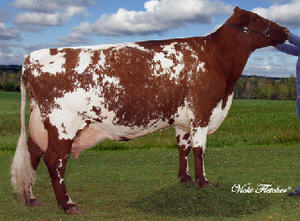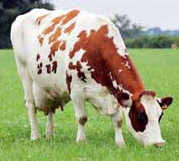



Dairy Shorthorn
History
The Shorthorn breed of cattle has evolved over the last two centuries, from Teeswater and Durham cattle found originally in the North East of England in the Tees river valley and Durham. In the late 18th Century two brothers, Charles and Robert Colling started to improve these Durham cattle using line breeding techniques established so successfully by Robert Bakewell on Longhorn cattle. In 1783 Charles Colling found four particular cows recorded as Duchess, Cherry, Strawberry, and Old Favourite among others, and at the same time his brother Robert had noticed the superiority of calves in the local market bred from a bull known as Hubback, which he subsequently bought for £8.It was a combination of these bloodlines, which led to the birth of the bull Comet bred by Charles Colling in 1804, and later sold at the Ketton sale in 1810 for 1,000gns. This was the first 1,000 guinea bull ever recorded, but the wisdom of this bid was later to be justified by his progeny and he has since become a legend in cattle breeding.
The breed was used in the early part of the 20th Century, primarily as a dual purpose breed, but specialisation for beef and milk led to the beef breeders starting their own section of the herd book in 1958.
The dairy breeders sought to improve the dairy aspect of their animals, and a blending scheme to introduce outside blood from other breeds was introduced in 1970. Some breeders did not wish to participate in this scheme, and so there is now quite a diversity of type within the Shorthorn breed. This diversity of type means that the Shorthorn can be used in a variety of different systems. In Ireland, the majority of Shorthorns are used for their suckler/beef capabilities, whereas in the UK the milking qualities of the breed have been developed.
The importance of the Shorthorn breed in the development of other cattle breeds is enormous, and Shorthorn genetics have been used worldwide in the development of over 40 different breeds. The breed has a very long and distinguished history, and developments on both the beef and dairy sides have ensured that the breed also has a very bright future.
The Dairy Shorthorn is also called the Milking Shorthorn in the USA and Canada.
 Photo courtesy of Oceanbrae Farms |
Characteristics
Dairy Shorthorns are either red, red and white, white or roan, the last named colour being a very close mixture of red and white, and found in no other breed of cattle. They can be horned or polled and are very docile in nature.They are moderately framed at approximately 142cm and 635-990kg and have comparatively small calves that are vigorous at birth and easy to raise. These hardy cows recover quickly and are in condition to rebreed earlier.
Shorthorn milk has the most favorable protein-fat ratio of the dairy breeds which is an added plus when marketing your milk for cheese. Shorthorns can be successfully crossed with any other dairy breed to quickly incorporate the Dairy Shorthorn-related grazing traits. Although no bulls can be completely trusted, Dairy Shorthorns tend to be quieter than other dairy bulls and fit well where a bull is used to get cows settled.
Shorthorns are also known for their structural soundness and longevity. Most cows are productive for five or more lactations, and several cows have produced in excess of 10,000 kgs per lactation at greater than ten years of age. Dairy Shorthorns have very few problems with feet and legs, allowing the producer to cut out the expenses of lost milk production, veterinary bills, and replacement animals due to feet and leg difficulties. Both cows and heifers are easy calvers and excellent mothers, substantially decreasing calf mortality or unthriftiness.
Dairy Shorthorns have been widely used as "foundation" females in the establishment of the European breeds introduced to Australia in more recent times (eg. Charolais, South Devon, Limousin, Maine-Anjou).
Statistics
- More efficient converter of feed to milk, especially pasture and other forages, lowering feed cost.
- Cows producing in excess of 9000 kgs of milk per 305 days on low input management.
- Superior feet and leg structure, with excellent hoof durability.
- Greater reproductive efficiency, with fewer days open, higher non-return rate of cows and heifers, and smaller calving intervals, meaning less wasted time and expense to the breeder.
- Ease of calving and excellent mothering ability - most cows require no calving assistance.
- Greater salvage value for bull calves and cull cows than other dairy breeds.
- Improved longevity, with the majority of cows lasting more than 5 lactations.
- According the Canadian Dairy Network (2001), the breed with the greatest percentage of cows recorded as very quiet or quiet temperament.
- According to recent CDN studies, the breed with the lowest average somatic cell score.
Comparative
In an extensive study done over a 13 year period on an Idaho dairy owned by a veterinarian, it was found that under the same management conditions, Dairy Shorthorns were significantly less prone to disease, particularly in the areas of lameness, mastitis, dystocia and milk fever, than their Holstein herdmates. (Paper presented at the 1995 World Shorthorn Conference by Dr. Martin R. Lee, Jerome, Idaho.)Lee (1995) notes that Milking Shorthorns have almost one half the incidence of cystic ovaries as Holsteins.
Milking Shorthorn milk can be worth more. On a recent USDA Sire Summary, Milking Shorthorns were listed with the lowest base Somatic Cell score of all dairy breeds, indicating the possibility of an increased resistance to mastitis which is consistent with the Idaho study.
Minnesota DHI data shows Milking Shorthorns as having the lowest feed cost per hundredweight of milk, and the lowest total dry matter intake per hundredweight of body weight.
The 1995 Minnesota DHIA data showed Milking Shorthorn cows with the shortest calving interval of any breed - 12.8 months. Fertility
Distribution
The Dairy Shorthorn is increasing in popularity and are found in the UK, the USA, Canada, Argentina, Brazil, Australia and New Zealand.References (the above information was cited from the following sites)
www.shorthorn.co.uk
www.milkingshorthorn.com
www.cmss.on.ca
Oceanbrae Farms


